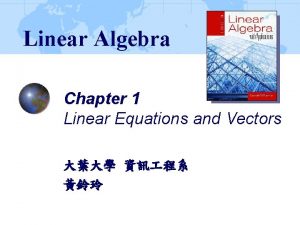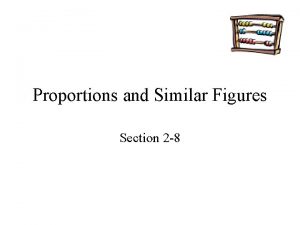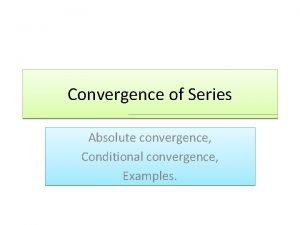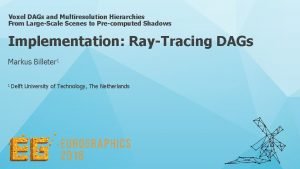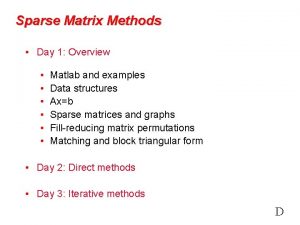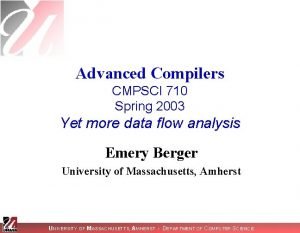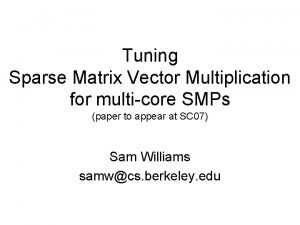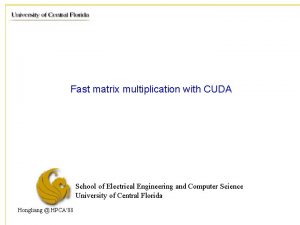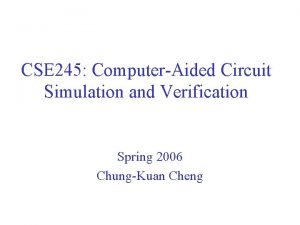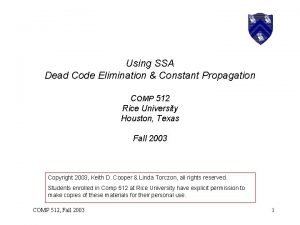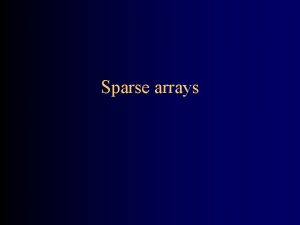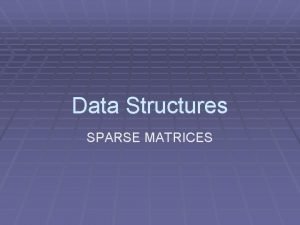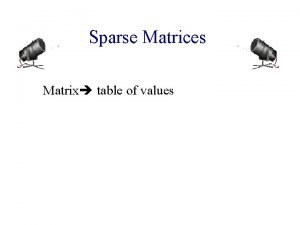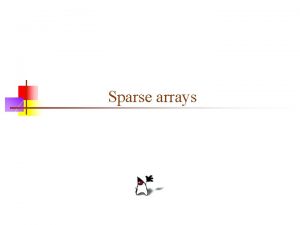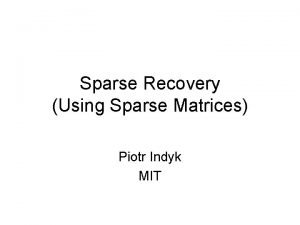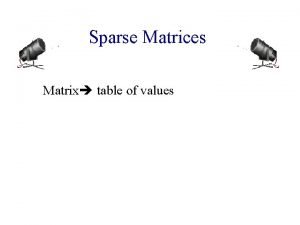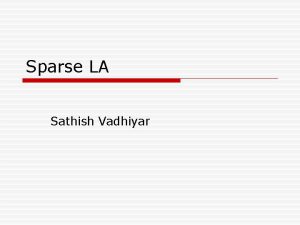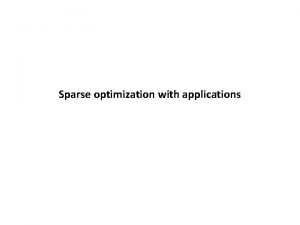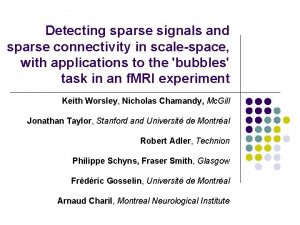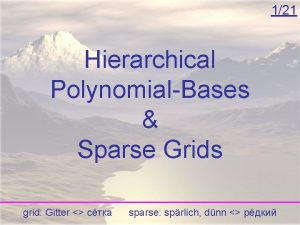A Sparse Solution of is Necessarily Unique Alfred



















- Slides: 19

A Sparse Solution of is Necessarily Unique !! Alfred M. Bruckstein, Michael Elad & Michael Zibulevsky The Computer Science Department The Technion – Israel Institute of technology Haifa 32000, Israel A Non-Negative Sparse Solution to Ax=b is Unique

Overview q We are given an underdetermined linear system of equations Ax=b (k>n) with a full-rank A. q There are infinitely many possible solutions in the set S={x| Ax=b}. q What happens when we demand positivity x≥ 0? Surely we should have S+={x| Ax=b, x≥ 0} S. k In nthis talk we shall briefly explain how this result is obtained, and discuss some of its implications q Our result: For a specific type of matrices A, if a sparse enough solution is found, we get that S+ is a singleton (i. e. there is only one solution). q In such a case, the regularized problem gets to the same solution, regardless of the choice of the regularization f(x) (e. g. , L 0, L 1, L 2, L∞, entropy, etc. ). A Non-Negative Sparse Solution to Ax=b is Unique 2

Preliminaries A Non-Negative Sparse Solution to Ax=b is Unique 3

Stage 1: Coherence Measures q Consider the Gram matrix G=ATA: q Prior work on L 0 -L 1 equivalence relies on a mutual-coherence measure defined by A = AT A TA (ai – the i-th column of A) q In our work we need a slightly different measure: . q Note that this one-sided measure is weaker (i. e. μ(A)≤ρ (A)), but necessary for our analysis. q Both behave like A Non-Negative Sparse Solution to Ax=b is Unique for random A with (0, 1)-normal and i. i. d. entries. 4

Stage 2: The Null-Space of A It is relatively easy to show that In words: a vector in the nullspace of A cannot have arbitrarily large entries relative to its (L 1) length. The smaller the coherence, the stronger this limit becomes. i A Non-Negative Sparse Solution to Ax=b is Unique 5

Stage 3: An Equivalence Theorem Consider the following problem with a concave semi-monotonic increasing function : Then A feasible solution x (i. e. Ax=b) to this problem is the unique global optimum if it is sparse enough: z Note: Similar (but somewhat different!) results appear elsewhere [Donoho & Elad `03] [Gribonval & Nielsen `03, `04] [Escoda, Granai and Vandergheynst `04]. A Non-Negative Sparse Solution to Ax=b is Unique 6

The Main Result A Non-Negative Sparse Solution to Ax=b is Unique 7

Stage 1: Limitations on A q So far we considered a general matrix A. q From now on, we shall assume that A satisfies the condition: The span of the rows in A intersects the positive orthant. q O+ includes § All the positive matrices A, § All matrices having at least one strictly positive (or negative) row. q Note: If then so does the product P·A·Q for any invertible matrix P and any diagonal and strictly positive matrix Q. A Non-Negative Sparse Solution to Ax=b is Unique 8

Stage 2: Canonization of Ax=b q Suppose that we found h such that q Thus, . . q Using the element-wise positive scale mapping we get a system of the form: q Implication: we got a linear system of equations for which we also know that every solution for it must sum to Const. q If x≥ 0, the additional requirement is equivalent to This brings us to the next result … A Non-Negative Sparse Solution to Ax=b is Unique . 9

Stage 3: The Main Result Given a system of linear equations Ax=b with we consider the set of non-negative solutions, k , n . Assume that a canonization Dz=b is performed by finding a suitable h and computing the diagonal positive matrix W: If a sparse solution found such that is Then then S+ is a singleton. A Non-Negative Sparse Solution to Ax=b is Unique 10

Sketch of the Proof Find h such that Non-negativity of the solutions implies that We are given a sparse solution z≥ 0, satisfying and … any solution of Dz=b satisfies Consider Q 1, the optimization problem The set S+ contains only z A Non-Negative Sparse Solution to Ax=b is Unique Canonize the system to become Dz=b using There is a one-to-one mapping between solutions of Dz=b and Ax=b By Theorem 1, z is the unique global minimizer of Q 1 No other solution can give the same L 1 length 11

Some Thoughts A Non-Negative Sparse Solution to Ax=b is Unique 12

How About Pre-Coherencing? q The above result is true to A or any variant of it that is obtained by A’=PAQ (P invertible, Q diagonal and positive). q Thus, we better evaluate the coherence for a “better-conditioned” matrix A (after canonization), with the smallest possible coherence: ρC h q One trivial option is P that nulls the mean of the columns. q Better choices of P and Q can be found numerically A Non-Negative Sparse Solution to Ax=b is Unique [Elad `07]. 13

SKIP? Solve If we are interested in a sparse result (which apparently may be unique), we could: q Trust the uniqueness and regularize in whatever method we want. q Solve an L 1 -regularized problem: . q Use a greedy algorithm (e. g. OMP): § Find one atom at a time by minimizing the residual , § Positivity is enforced both in: • Checking which atom to choose, • The LS step after choosing an atom. q OMP is guaranteed to find the sparse result of enough [Tropp `06], [Donoho, Elad, Temlyakov, `06]. A Non-Negative Sparse Solution to Ax=b is Unique , if it sparse 14

OMP and Pre-Coherencing? q As opposed to the L 1 approach, pre-cohenercing helps the OMP and improves its performance. q Experiment: § Random non-negative matrix A of size 100 200, § Generate 40 random positive solutions x with varying cardinalities, § Check average performance. § L 1 performs better BUT takes much longer ( ). § OMP may be further improved by better pre-coherencing. A Non-Negative Sparse Solution to Ax=b is Unique 15

Relation to Compressed Sensing? q A Signal Model: b belongs to a signal family that have a (very) sparse and non-negative representation over the dictionary A. k n A Non-Negative Sparse Solution to Ax=b is Unique 16

Relation to Compressed Sensing? q A Signal Model: b belongs to a signal family that have a (very) sparse and non-negative representation over the dictionary A. q CS Measurement: Instead of measuring b we measure a projected version of it Rb=d. A Non-Negative Sparse Solution to Ax=b is Unique 17

Relation to Compressed Sensing? q A Signal Model: b belongs to a signal family that have a (very) sparse and non-negative representation over the dictionary A. q CS Measurement: Instead of measuring b we measure a projected version of it Rb=d. q CS Reconstruction: We seek the sparsest & non-negative solution of the system RAx=d – the scenario describe in this work!! q Our Result: We know that if the (non-negative) representation x was sparse enough to begin with, ANY method that solves this system necessarily finds it exactly. q Little Bit of Bad News: We require too strong sparsity for this claim to be true. Thus, further work is required to strengthen this result. A Non-Negative Sparse Solution to Ax=b is Unique 18

Conclusions q Non-negative sparse and redundant representation models are useful in analysis of multi-spectral imaging, astronomical imaging, … q In our work we show that when a sparse representation exists, it may be the only one possible. q This explains various regularization methods (entropy, L 2 and even L∞) that were found to lead to a sparse outcome. q Future work topics: § Average performance (replacing the presented worst-case)? § Influence of noise (approximation instead of representation)? § Better pre-coherencing? § Show applications? A Non-Negative Sparse Solution to Ax=b is Unique 19
 Sparse solution
Sparse solution Unique solution matrix
Unique solution matrix Pqdn
Pqdn Similar figures have the same but not necessarily the same
Similar figures have the same but not necessarily the same Anything worth doing is not necessarily worth doing well
Anything worth doing is not necessarily worth doing well Similar polygons formula
Similar polygons formula If the absolute value of a series converges
If the absolute value of a series converges Vapour pressure
Vapour pressure Dante e petrarca a confronto
Dante e petrarca a confronto Sparse voxel dag
Sparse voxel dag Sprand matlab
Sprand matlab Sparse conditional constant propagation
Sparse conditional constant propagation Sparse matrix
Sparse matrix Sparse matrix in data structure
Sparse matrix in data structure Nvidia t239
Nvidia t239 Sparse tableau analysis
Sparse tableau analysis Sparse conditional constant propagation
Sparse conditional constant propagation Efficient sparse voxel octrees
Efficient sparse voxel octrees Sparse lookup in datastage
Sparse lookup in datastage Efficient sparse voxel octrees
Efficient sparse voxel octrees

